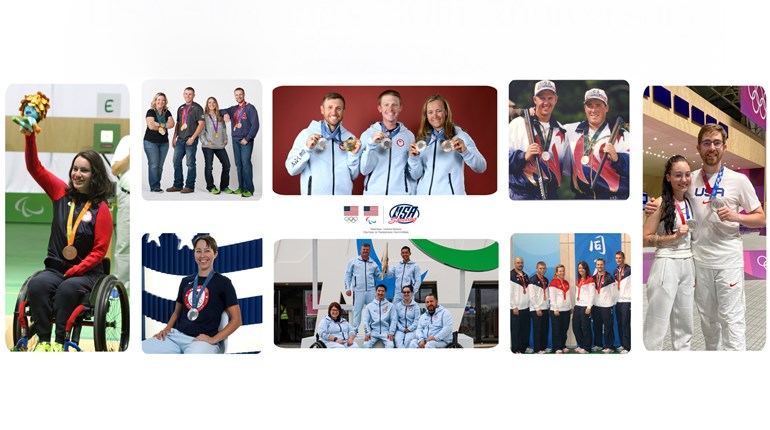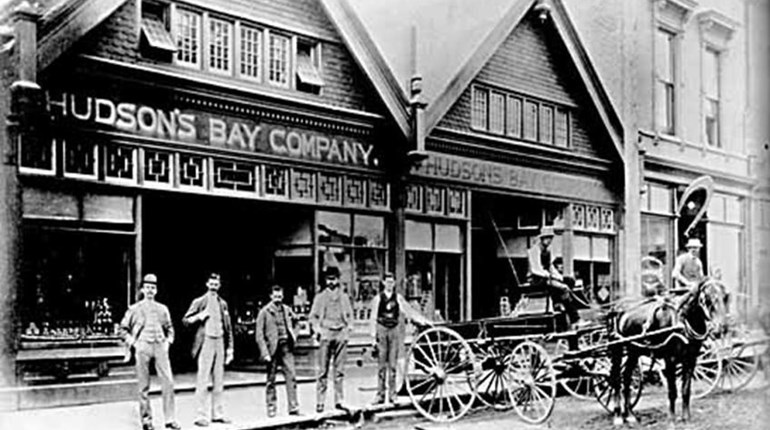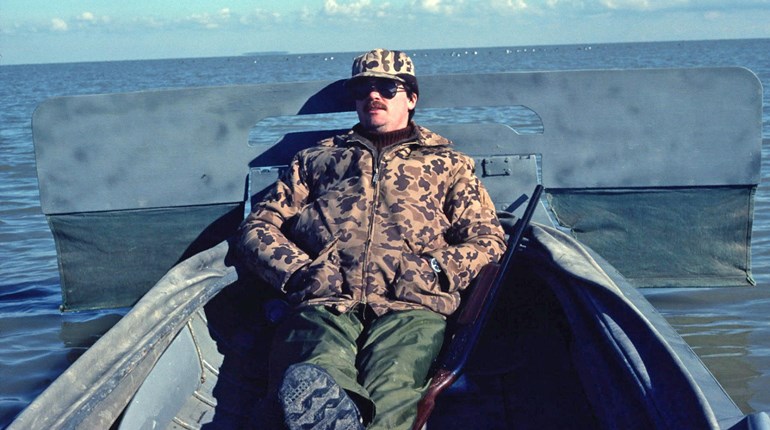
The below is an excerpt from the 1978 book, Olympic Shooting, written by Col. Jim Crossman and published by the NRA. (Pictured above are three participants in the 1900 Olympic Games live pigeon shoot—(l.-r.) Maurice Fauré of France, Léon de Lunden of Belgium and Donald Mackintosh of Australia.)
1900—Paris: And It Was A Mistake
By Colonel Jim Crossman
With the successful I Olympic Games of Athens as a model, it seemed logical that the next country to hold the Games would have an easier job and would be able to introduce a number of improvements. It seemed logical that other countries would be eager for the honor of being assigned the Games. It seemed logical that the energetic founder, Baron de Coubertin, would be honored by his own country and would be given a place of importance in planning of the next Games.
All of which merely shows that people do not do the logical thing. The second Olympic Games went to Paris and, by all accounts, they were a mess.
The French took little interest in sports, and the Games were considered a mere sideshow—second rate at that—to the main business of that year, the Paris Exposition of 1900. The Baron was pushed off to one side, and no one else was much interested in doing any planning. There was no promotional activity, and it was not until just a month or so before the Games were to open that the U.S. athletes got information on the program and the rules, which caused concern. Some of the final contests were scheduled for Sunday, and many athletes were opposed to Sunday athletics. There was no U.S. squad as such, but various clubs and colleges sent teams, as they had in 1896. Some of the organizations would not let their people compete on Sunday, while others made it optional.
This was only one of many things which bothered the athletes.

The conditions for the track and field events were very poor. There never had been a cinder track in France, so the short-distance runners ran on grass. Although there were well over 1,000 competitors in various events, the promotion was so poorly done that the spectators barely outnumbered the participants. Many observers felt that the exposition itself was not really first rate, but all travelers who have gone to Paris since 1900 have viewed the Eiffel Tower, that wonder of wonders built especially for the exposition.
The American shooter had an easier time of it than the athlete, at least as far as getting information on the program was concerned. If he read the columns of Shooting and Fishing, he could keep up on U.S. and foreign happenings in shooting. In addition to covering competitive shooting, this weekly magazine covered hunting, fishing and many other outdoor activities.
Shooting and Fishing was not the only magazine of the time which covered these activities, and not even the only weekly. Among the famous magazines which appeared weekly or monthly and which gave space to shooting in its various forms were The Sportsmen's Review, Forest and Stream, Sports Afield, Outdoor Life and Field and Stream. The shooter had to follow his game in one of these commercial magazines, because it was many years before Shooting and Fishing turned into Arms and the Man (later American Rifleman) and became the official publication of the National Rifle Association.
At this time, the United States Revolver Association was just being formed and it had no publication, skeet had not been invented, and the Sportsmen's Review had not yet become the magazine of the trapshooters.
In the spring of 1900, the columns of Shooting and Fishing carried a long letter from the President of the United Shooting Clubs of France outlining the shooting matches scheduled with the exposition. The exposition managers had charged the Union des Societes de Tir de France with running the rifle and pistol shooting activity. The president of the shooting union wrote an enthusiastic letter on March 1, 1900, earnestly inviting American shooters and enclosing details on the program.
According to this account, there were nearly 11,000 prizes to be given in 24 contests with rifles, carbines, revolvers, pistols and firearms of any make, including French military arms. There were additional contests for the shotgun, the bow and arrow, the crossbow and the cannon—French as well as foreign—at both short and long ranges. The shotgun contests included both live pigeon and clay target events.
Unfortunately, the program is not too clear, and it is difficult to identify all the events on the schedule. There were a couple, however, that were to become familiar. One was the free rifle match, with any rifle having iron sights, 40 shots each prone, kneeling and standing, on a target 1 meter (39 inches) across and with 10 scoring rings, at a distance of 300 meters (333 yards). The other classic was the free pistol match, 60 shots at 50 meters (55 yards) at a target with 10 rings, 50 centimeters (20 inches) across. The original French match was limited to any revolver, however.
In addition, there was a running boar match at 40 meters (44 yards), with the boar running 6 meters (6.7 yards), a match for 6 mm (1/4 inch) carbines at 12 meters (13 yards), various events for military rifles at 200 meters (222 yards) on a target 80 centimeters (31 inches) across with 10 rings, and a match at 200 meters on a man-sized silhouette.
The National Rifle Association of America was in the doldrums at that time, almost out of business. That great shooting promoter, Brigadier General Bird Spencer, Inspector General of Rifle Practice, State of New Jersey, took the bull by the horns and announced tryouts for an American rifle team to go to Paris. The tryouts were to be held at the New Jersey range at Sea Girt. Apparently something happened along the way, because there is no record of the tryouts and a rifle team did not get to France.
The United States Revolver Association was just being formed at this time, as the result of a match challenge issued by a French group headed by Gastinne-Renette. The match, however, was not to be shot at the exposition, but was to be a postal match, with each team shooting at home and mailing the results to the other side. This match consisted of 10-person teams, each shooting two courses-of-fire, one proposed by each country. This match created much more excitement and interest in this country than did the Paris Games.
Dr. Reginald H. Sayre, one of the founders of the U.S. Revolver Association and a great shot of the day, stayed in New York long enough to shoot in the Franco-American match, and then boarded a ship headed for England to shoot in the Bisley matches. But his main purpose was to go on to France to organize the American handgun team for the big team match at the exposition. He planned to get a team together from the American shooters who were known to be overseas, but his efforts were doomed to failure.
According to the Shooting and Fishing report on the match:
"It has been a great disappointment among Frenchmen not to see our American friends in the international shooting matches. Certainly Dr. Sayre cannot be blamed, because he did his best to organize a team for the revolver with Messrs. Wesson, Peabody, Flagg, Seligman, Axtell, Hodskins; but Mr. Seligman was in Marienbad at that time, and did not see any possibility of being back in time for the match, and the team was obliged to withdraw. The rifle team had not that opportunity, because it did not enter at all. It is surprising that more American marksmen did not try their chance here. It was a splendid opportunity, and they surely missed it. I cannot understand why, with 72,000,000 people, two teams of five delegates were not present. I think shooting in the United States is neglected, and has not the proper support, and no national organization."
The French writer of this report could have been forgiven his criticism of the American effort when one looked at the activity in his country. According to Dr. Sayre, there were over 600 entries in the French handgun matches at Camp De Satory, as well as over 1,600 entrants in the rifle matches. In 1900, the number of shooting societies affiliated with the Union Des Societes de Tir was 677, with a claimed membership of over 120,000.
If the U.S. was not well represented, other nations were. At the ranges at Camp de Satory (Versailles, Paris), the Swiss team took first place in the classic 300-meter, 3-position match with 4399, 106 points over Norway. The Swiss Kellenberger won the 3-position individual match with 930. Madsen, Denmark, took the standing stage with 305, Staeheli of Switzerland had 324 for the kneeling award, and Paroche of France had 332 in prone. Practically all the Swiss shooters in this match used the Swiss Martini rifle chambered for the 7.5 mm cartridge. According to the report, there were over 20,000 rounds of 7.5 mm ammunition fired during the meeting. There were many more matches for the French Lebel rifle and many more shooters, who fired 300,000 rounds of the military 8 mm cartridge. The popular rifle for the wild boar match was the .32 Winchester, and 13,000 rounds were fired.
All was not work for the shooters, however. When they were not on the range, they could visit the many excellent displays of rifles, pistols and shotguns where the French gunmakers showed their best. The finest of the British guns gave the French much competition.
One of the more popular displays was that of the Smith & Wesson company. In addition to showing their line of guns to best advantage, the display had an indoor shooting range with facilities for spectators. The purpose of the range was to show the fine accuracy of Smith & Wesson revolvers.
Large crowds gathered every day to watch American shooters C.S. Axtell and F.G. Hodskins put on demonstrations and to get a target to take home as a souvenir. The demand for targets was so great that Axtell and Hodskins had to fasten targets together in a stack so that they could shoot several simultaneously. Axtell, along with Sayre, had shot earlier in the English Bisley matches and had done very well. Axtell and Hodskins shot in some of the Paris individual matches.
The international revolver match, 60 shots at 50 meters, was won by the 5-man Swiss team of Roderer, Staeheli, Richardet, Luthi and Probst, with France in second place. Roderer was high man of all the team shooters with a score of 503.
Although this whole affair was supposed to be an Olympic Games, it was mostly considered merely a sideshow for the exhibition, and the Olympic title was not often used in connection with the activities. Unlike other Games, there was never an official report published on the organization and results of the 1900 Games. The nearest thing to an official document was the U.S. Olympic Committee's Quadrennial Review, which listed winners of some 1900 events. While some of the cited results were correct in the earlier Reviews, in some strange manner a few results were shown which actually were for Games conducted eight years later. Later editions are more nearly correct. Various books on the subject offer conflicting data, most books even being inconsistent within themselves. In view of the complexity of the matches, this is not surprising.
The accompanying table is partially taken from a report of 1900 in Shooting and Fishing, in which some things are very clear but others are a bit hazy. Additional results are taken from other sources and are somewhat doubtful, although they seem reasonable.
The report shows that no U.S. team competing in any of the events, but lists the following Americans as shooting in one or more events and winning prizes. As a matter of fact, it was hard not to win something, with nearly 11,000 prizes offered. According to the list, silver cups in a rifle match were won by: C.S. Axtell, Dr. Sayre, F.G. Hodskins, E. Geisel, D.W. Seligman and Robertson. The same five men are listed as having won first prizes on the silhouette target at 20 meters with the French army rifle.
There is no doubt that Baron de Coubertin felt very badly about having his great Olympic ideal so misunderstood, and the II Olympic Games so badly handled by his own countrymen. It was obvious that they either did not understand the Olympic philosophy or just did not care about it. And this was too bad, after the surprisingly good start made with very short notice at Athens four years before. Not only were the organizers of the Games indifferent to them, but the French people did not know what they had and did not come to find out.
Maybe it would have been better to have gone back to Athens. The Greeks felt they had some proprietary rights on the Olympic idea, and they wanted to hold them in Athens every four years. The Baron thought the Games should be moved around among the nations, to spread the interest and enthusiasm and to encourage building sports facilities in various countries (although it did not work too well in France). If the Greeks had not suddenly ended up with a war on their hands, the second Games might well have gone back to Athens. But Paris it was.
The Baron, with his great concern for amateur athletics must have been considerably disturbed by the Games program which first arrived in the U.S. only a month or so before the Games were to begin. Each of the prizes was listed as an "object of art," but with a careful note to show its money value. Generally, first prizes were worth about $80, but some ran up to several hundred dollars. The 11,000 shooting prizes were listed at a total value of about $40,000.
The early invitation to the shooting match said:
"... these contests will afford an opportunity for every person attending them, not only to win one or more of the many valuable prizes to be awarded to the successful competitors, but also a chance of visiting the imposing Centennial Paris Exposition; the prizes in many cases being valuable enough to go a generous way toward defraying the expenses of the entire trip."
And when the winner of one of the equestrian events was offered a cash prize of $1,200 and a win in the track and field events meant $800, it was obvious that the exposition promoters had completely missed the point of the Baron's Olympic philosophy. No doubt about it, Paris was a mistake.
1900 Match Results
Official rules are not available. A letter of March 1, 1900, published in Shooting and Fishing, April 19, 1900, gives some information on numerous rifle and handgun shooting events. A later letter in Shooting and Fishing, September 20, 1900 gives some results.
Target Sizes
- 200 meters: 80 centimeters (31.5 inches) diameter; 10 scoring rings; black aiming mark 40 centimeters (15.7 inches).
- 300 meters: 1 meter (39.37 inches) diameter; 10 scoring rings; black aiming mark 60 centimeters (23.6 inches).
- 20 meters: 30 centimeters (11.8 inches) diameter; 10 scoring rings; black aiming mark 20 centimeters.
- 50 meters: 50 centimeters (19.7 inches) diameter; 10 scoring rings; black aiming mark.
- 12 meters: 55 millimeters (2.16 inches) diameter; bullseye 18 millimeters (0.7 inch).
Rifle Match, 300 meters—40 shots each in prone, kneeling and standing positions; 5-man team
- Switzerland, 4399
- Norway, 4293
- France, 4278
Any Revolver Match, 50 meters—10 series of 6 shots per man; 5-man team; 50 meters
- Switzerland, 2271
- France, 2204
- Holland, 1876
Rifle Match, 300 meters—40 shots each, prone, kneeling and standing positions
- Emil Kellenberger (Switzerland), 930
Rifle Match, 300 meters—40 shots, standing
- Lars Jorgen Madsen (Denmark), 305
Rifle Match, 300 meters—40 shots, kneeling
- Konrad Staeheli (Switzerland), 324
Rifle Match, 300 meters—40 shots prone
- Paroche (France), 332
Revolver Match, 50 meters—60 shots, any revolver
- Karl Roderer (Switzerland), 503
Service Revolver Match, 20 meters
- M. Larrouy (France), 58
- M.E. Moreaux (France), 57
- A. Morlan (France), no score given
Miniature Rifle Match, 12 meters—open sights
- C. Grosset (France), no score given
Running Deer Match Single Shot, 40 meters
- L. DeBray (France), no score given
- P. Nivet (France), no score given
- deLambert (France), no score given
Clay Target Match
- R. DeBarbarin (France), no score given
- G. Guyot (France), no score given
- Clary Graf (France), no score given


































